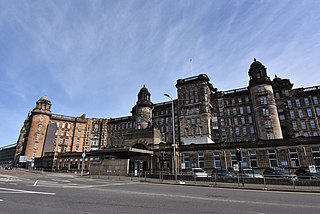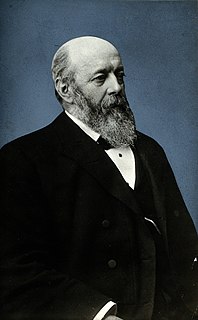Related Research Articles

The Glasgow Royal Infirmary (GRI) is a large teaching hospital. With a capacity of around 1,000 beds, the hospital campus covers an area of around 8 hectares, and straddles the Townhead and Dennistoun districts on the north-eastern fringe of the city centre of Glasgow, Scotland. It is managed by NHS Greater Glasgow and Clyde. It was originally opened in 1794, with the present main building dating from 1914.

The University of Glasgow School of Medicine, Dentistry & Nursing is the medical school of the University of Glasgow, Scotland, and is one of the largest in Europe, offering a 5-year MBChB degree course. It is ranked 2nd in the UK for medicine by The Times Good University Guide 2018 and joint 1st in the UK by the Complete University Guide 2021. The School of Medicine uses lecture-based learning, problem-based learning and Glasgow's case-based learning.
Sir Charles Robert Harington, KBE, FRS was a chemist, best known for synthesising thyroxine.
Sir John Fraser, 1st Baronet, was Regius Professor of Clinical Surgery at Edinburgh University from 1925 to 1944 and served as principal of the University of Edinburgh from 1944 to 1947.
Malcolm Andrew Ferguson-Smith, is a British geneticist.
Thomas Jones Mackie CBE FRSE LLD was a noted Scottish bacteriologist; Dean of the Faculty of Medicine, University of Edinburgh; and author of medical research textbooks.

Sir Thomas Grainger Stewart was an eminent Scottish physician who served as president of the Royal College of Physicians of Edinburgh (1889–1891), president of the Medico-Chirurgical Society of Edinburgh, president of the medicine section of the British Medical Association, and Physician-in-Ordinary to the Queen for Scotland. He was perhaps best known for describing the condition known as multiple neuritis as well as directing scientific attention in Great Britain to the deep reflexes.

John Gray McKendrick FRS FRSE FRCPE LLD was a distinguished Scottish physiologist. He was born and studied in Aberdeen, Scotland, and served as Regius Professor of Physiology at the University of Glasgow from 1876 to 1906. He was co-founder of the Physiological Society.

Charles Frederick William Illingworth was a British surgeon who specialised in gastroenterology. Along with a range of teaching and research interests, he wrote several surgical textbooks, and played a leading role in university and medical administration.
John Russell Anderson was a Scottish pathologist, Professor of Pathology at the Western Infirmary, University of Glasgow, 1967–1983. Colleagues knew him as JRA.

James Finlayson was a Scottish surgeon, physician, and prolific writer on medical and historical topics.

Sir Byrom Bramwell FRSE LLD was an eminent British physician and medical author. He was a general physician, but became known for his work in neurology, diseases of the heart and blood, and disorders of the endocrine organs. He was president of the Royal College of Physicians of Edinburgh.

John Chiene, CB, LLD, MD, FRSE, FRCSEd was a Scottish surgeon, who was Professor of Surgery at the University of Edinburgh during some of its most influential years. He was a founder of the Edinburgh Ambulance Service. The Chiene Medal is presented as an annual prize in surgery at the University. He served as President of the Royal College of Surgeons from 1897-99.
David Middleton Greig FRSE FRCSE LLD TD was a Scottish surgeon who worked for most of his career at Dundee Royal Infirmary. He developed an interest in diseases of bone and came to be regarded as an international authority on the subject. He wrote numerous papers on skeletal abnormalities and Greig cephalopolysyndactyly syndrome is named after him. Over the course of his career he amassed a large collection of skulls demonstrating various bony abnormalities. After retiring from surgical practice he became conservator of the Museum of the Royal College of Surgeons of Edinburgh at Surgeons' Hall. He donated 250 skulls to Surgeons' Hall Museum, where some remain on display as part of the Greig Collection.
Robert Kirk (1905-1962) was a Scottish parasitologist and pathologist.
Malcolm Stewart Muir FRSE (1930–1995) was a 20th-century British epidemiologist and "geographic pathologist". Friends and colleagues knew him as Calum Muir. Famed for his cancer research he was a joint founder of the Singapore Cancer Society and served as its Secretary 1964 to 1967.
Francis Esmond Reynolds FRSE (1882–1967) was a 20th-century British pathologist and medical author.

Thomas Kennedy Dalziel known as T Kennedy Dalziel was a Scottish surgeon and pathologist who specialised particularly in abdominal surgery. Dalziel was most notable for being considered the best technical surgeon at the time in western Scotland. He was also particularly notable for the discovery of a disease called chronic interstitial enteritis in 1913, that later became known as Crohn's disease.
Extramural medical education in Edinburgh began over 200 years before the university medical faculty was founded in 1726 and extramural teaching continued thereafter for a further 200 years. Extramural is academic education which is conducted outside a university. In the early 16th century it was under the auspices of the Incorporation of Surgeons of Edinburgh (RCSEd) and continued after the Faculty of Medicine was established by the University of Edinburgh in 1726. Throughout the late 18th and 19th centuries the demand for extramural medical teaching increased as Edinburgh's reputation as a centre for medical education grew. Instruction was carried out by individual teachers, by groups of teachers and, by the end of the 19th century, by private medical schools in the city. Together these comprised the Edinburgh Extramural School of Medicine. From 1896 many of the schools were incorporated into the Medical School of the Royal Colleges of Edinburgh under the aegis of the RCSEd and the Royal College of Physicians of Edinburgh (RCPE) and based at Surgeons' Hall. Extramural undergraduate medical education in Edinburgh stopped in 1948 with the closure of the Royal Colleges' Medical School following the Goodenough Report which recommended that all undergraduate medical education in the UK should be carried out by universities.

Joseph Coats was a pathologist and emeritus professor of Pathology at the University of Glasgow. Coats wrote the first book on practical pathology, that became the bible of the profession.
References
- 1 2 "Biography of John Teacher". University of Glasgow. Retrieved 2019-01-07.
- ↑ "John Hammond Teacher. 1869–1930". The Journal of Pathology and Bacteriology. 34 (2): 290–297. 1931-01-01. doi:10.1002/path.1700340221. ISSN 1555-2039.
- ↑ "John Hammond Teacher, M.A., M.D". British Medical Journal. 2 (3648): 982–983. 6 December 1930. ISSN 0007-1447. PMC 2452843 . PMID 20775880.
- ↑ "John Hammond Teacher - Obituary" (PDF). 1931. pp. 284–289. S2CID 53429643. Archived from the original (PDF) on 2019-01-08.